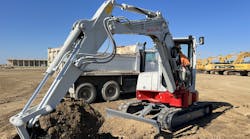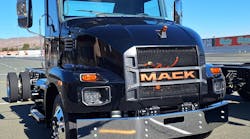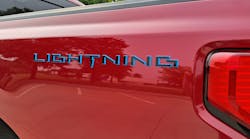By his own admission, Junior Green typically has little time or tolerance for salespeople who arrive without appointment at Gulf Coast Sand Products, a concrete recycling company that he and business partner, Todd Ramsey, operate in Bacliff (near Houston), Texas. So, when Tom Ling, regional sales manager for Atlas Copco Construction Tools, made a late-Friday-afternoon cold call on the company, he was fortunate, indeed, to be allowed the time for explaining how his company's products might benefit Gulf Coast Sand Products. As it turned out, the three struck a deal that might be of great value to both parties. Allow us to ex-plain.
Gulf Coast Sand Products has had a long, profitable existence selling recycled concrete, which originates from such sources as road-rehabilitation, sidewalk and patio replacement, and leftover ready-mix. The company separates this material by screening — first with a "bull screen" that passes all but the largest material, then with a powered screening plant that separates the remainder into four basic products — ranging from fines to 12-inch-plus material. The company not only finds ready markets for these sized materials, but also uses them in its related business of installing riprap barriers along Houston's continually eroding shoreline.
But the composition of the company's incoming materials has been changing in the past couple of years. For example, excess ready-mix, left in the truck at the end of the delivery or at the end of the day, has always been somewhat of a staple raw material. The supply of this material has been dwindling, however, as more ready-mix producers recycle the still-fluid concrete into their production operation. At the same time, an increasing volume of concrete rubble from Houston's construction community (much of it containing reinforcing steel) has been piling up in the company's 35-acre processing yard. All of this was forcing Green and Ramsey to find an alternate method for sizing material that more and more did not lend itself to separation by screening.
A crushing plant seemed to be the best solution. But that decided, the consideration remained about how best to accomplish primary reduction of rubble too large to pass the crusher's grizzly. And the rebar complicated the situation.
Just about this time, Ling, whose job includes promoting the market for Atlas Copco's silent demolition tools, called on Green and Ramsey. The three agreed that if Gulf Coast Sand Products would install the "wet kit" (hydraulic plumbing) required for its Hyundai R210LC-7 hydraulic excavator to use an appropriately sized Atlas Copco combination cutter, then the company could use the tool for 60 days in order to evaluate it as a possible solution for its primary-reduction needs. In return, Ling could bring in other prospects to see the tool in action.
Construction Equipment's involvement in this arrangement resulted from Atlas Copco's suggestion that Gulf Coast Sand Products actually use two combination cutters — the model CC ("Combi Cutter") 1501, and also the model CC 1700, which recently replaced the CC 1501. This arrangement would allow us to conduct a hands-on comparison of design features between the new and displaced tools, as well as to compare their relative production potential. The idea seemed to us a good way to learn more about silent-demolition tools and to observe how design refinement might be making these tools more effective and easier to use.
So on a hot, humid day in mid-June, the Construction Equipment crew met up with representatives from Atlas Copco and Gulf Coast Sand Products at the latter's processing yard in Bacliff. From Atlas Copco were Ling; Keith Becker, national service manger; and Charlie O'Dell, service technician based at Atlas Copco's service center in Round Rock (near Austin), Texas. From Gulf Coast Sand Products were Junior Green, Todd Ramsey, and his brother Rodney Ramsey.
Combination-cutter basicsSilent demolition tools, as the name implies, don't make much noise, that is, compared with hydraulic breakers. These tools (actually attachments for hydraulic excavators) are designed primarily to process masonry and steel debris, whether by using them to completely or selectively demolish structures, or to subsequently reduce the resulting debris.
The tools typically work by crushing or cutting material between two moving jaws, or between a single moving jaw and a stationary jaw. A wide range of these devices is available —identified variously as combination cutters, universal cutters, pulverizers, crackers, shears and grapples — and sold under such brand names as Allied-Gator, Atlas Copco, BTI, Genesis, LaBounty and Tramac.
As already noted, Ling initially suggested an Atlas Copco combination cutter to process the growing piles of roadway and bridge concrete at Gulf Coast Sand Products, most of it containing rebar. The Atlas Copco combination cutter has two moving jaws —one with a single blade, the other with a double blade — each powered by a stubby, large-diameter hydraulic cylinder that generates tremendous force that is multiplied though the levering action of the jaws. The CC 1700, for example, produces 441,000 pounds of maximum cutting force.
The term "combination" derives from the tool's capability to process both concrete and steel. Atlas Copco combination cutters can be used with a "universal" jaw set or with a "steel-cutting" jaw set. The former can process both concrete and steel, while the latter is designed for day-in, day-out processing of heavy steel components.
From what we observed at Gulf Coast Sand Products, the universal jaws had absolutely no problem getting through concrete containing rebar and, after watching Green take on a large, 12-inch-deep, 5-inch-wide, 3/8-inch-thick I-beam with these jaws, we were impressed, too, by how well they worked in this toughapplication. But after Becker and O'Dell switched from universal to steel-cutting jaws on the CC 1700, we also noted how much faster and more efficiently the latter sliced through the big beam.
Checking speed and specsTo demonstrate the relative production capacities of the CC 1501 and CC 1700, Rodney Ramsey first used the CC 1501 to process two piles of material — the first consisted of leftover ready mix, and the other consisted of large chunks of roadway and bridge concrete with rebar. We timed him as he reduced these materials to piles of rock, most with a top size of about 6 inches, which allowed the rebar to fall free from the material in the second pile.
After Becker and O'Dell switched the CC 1501 for the CC 1700 on the Hyundai, Ramsey repeated the process on similar piles of material. We again timed the process, and then compared the number with that of the CC 1501. We realize, of course, that this is far from a closely controlled production study, but we generally concluded that the CC 1700 was around 25 percent faster.
This squares with a quick experiment we did with Becker in timing the functions of each tool — rotate right, rotate left, jaw open, jaw close and a complete jaw open/close cycle. When comparing times for the open/close cycles, we noted an approximate 30 percent speed advantage for the CC 1700.
The CC 1700 has a flow rating of 40 to 66 gpm for its jaw operation, so it could use all of the Hyundai's rated 58-gpm hydraulic flow. (Actually, an on-site check indicated that the Hyundai was producing a maximum flow of slightly more than 60 gpm.) The CC 1501, however, has a flow rating of 26 to 40 gpm, and the machine's flow had to be restricted by means of a pressure-reducing valve installed between the pilot system and the auxiliary section of the main valve.
The CC 1501 has a maximum operating pressure of 4,660 psi, pretty much a match for the Hyundai's 4,690-psi implement circuit. The CC 1700, however, has a maximum operating pressure of 5,150 psi, so it was, in effect, running at a slight disadvantage with the Hyundai's 4,690-psi pressure. Although the Hyundai does have a power-boost system, which temporarily raises main pressure to 5,120 psi at the touch of a button in the left joystick, Ramsey did not employ the system when closing the jaws of the CC 1700.
But that said, our perception was that the CC 1700 shattered material with more force than did the CC 1501. This perception might have resulted from the new tool's increased speed, coupled with changes in the geometry of the jaws and their mounting position, which give slightly more maximum cutting force to the new tool.
We also measured the basic dimensions of the universal jaw set for both tools and found that while the CC 1700 has a slightly smaller tip-to-tip opening (29-1/2 versus 31-3/8 inches), the new tool's jaw depth (the vertical distance from a line struck across the jaw tips to the tool's housing) was 45 percent greater, 28-1/2 versus 19-1/2 inches. The increased jaw depth allows the new tool to more easily accommodate large pieces of debris.
But the real difference between the jaw sets of the two tools is the manner in which they are mounted in their respective housings.
Refined Combi designEach jaw in the set for the CC 1501 is mounted to the housing with its own 4-inch-diameter pin. If the user wants to switch jaw sets, say from the universal to the steel-cutting type, each of the mounting pins must be removed, and when the pins are pulled, each jaw is freed individually and must be supported. Although Becker and O'Dell didn't change jaw sets on the CC 1501, they told us that experts at the Atlas Copco factory in Germany estimate that a jaw-set change on the CC 1501 could require up to eight hours.
By contrast, the jaw sets for the CC 1700 are designed with Atlas Copco's new (and patented) coupling-and-positioning system (CAPS). The two distinctive design elements of this system are that both jaws are mounted in the housing with a single pin, and that the jaws remain connected as a set — even when the pin is removed. These features vastly simplify the process of switching between jaw sets.
Becker and O'Dell switched between the CC 1700's universal jaw set and its steel-cutting jaw set, and then back again. The first switch (and also the first time the two had performed this task) required 33 minutes. On the second switch, with Ramsey in the cab of the excavator nudging components into alignment, Becker and O'Dell accomplished the job in just slightly more than 15 minutes.
Also simplifying the jaw-set switch on the CC 1700 is the provision Atlas Copco has made for securing the cylinders in their relative mounting positions when disconnected from the jaws. With the CC 1501, the disconnected cylinders swing down against the tool's housing, requiring a lot of muscle (even a small service crane) to get them back into the proper attitude for mounting.
Once the jaws are installed on the CC 1501, adjusting the blade-to-blade clearance between the two jaws (the blades are bolted into the jaws) is a painstaking process that involves using the threaded mounting-pin caps to push the jaws horizontally until the proper dimension is attained. The CC 1700 simply uses shims under the blades to adjust this dimension (and to compensate for wear).
Summing upAs we expected, we learned much about silent demolition tools (combination cutters in particular) during our visit to Gulf Coast Sand Products. We were impressed with the tremendous power these tools generate, both when crushing concrete and when slicing through massive steel structures. From what we observed, the combination cutters seemed to be accomplishing what Gulf Coast Sand Products had hoped — quick reduction of material in a fashion that allows most of the rebar to fall free. The company's probable next step is deciding on a crusher. It's always good to see a small company with the foresight and flexibility to adapt when it sees the basics of its business changing.






